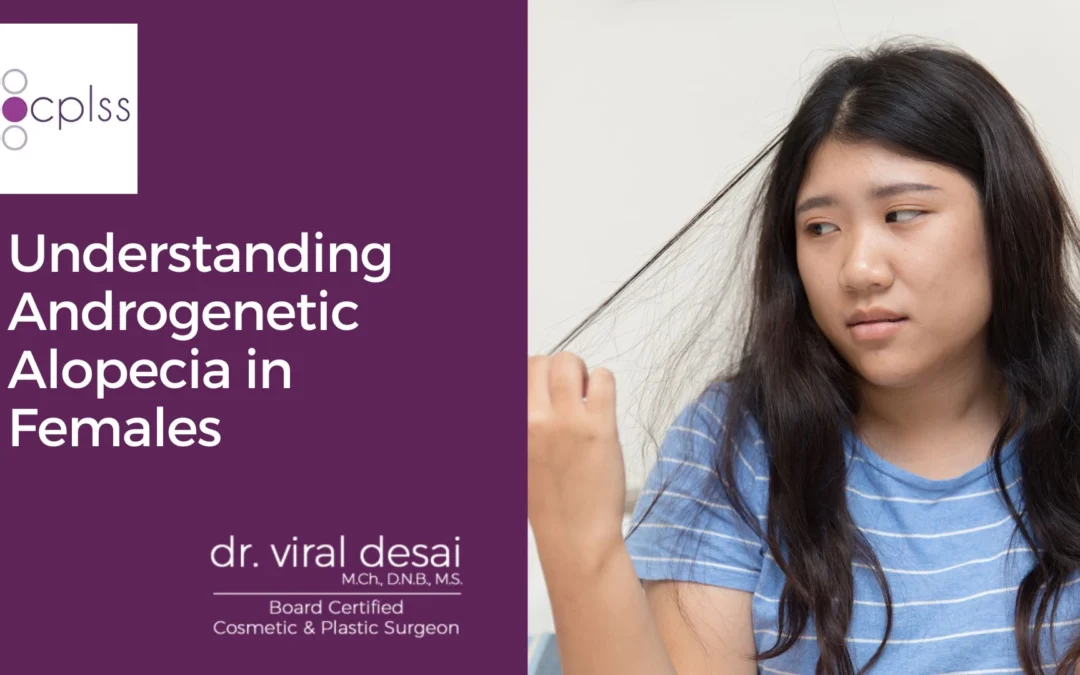Hair loss can be a distressing experience for anyone, but for females dealing with androgenetic alopecia, it can be particularly challenging. In this comprehensive guide, we will delve into the intricacies of androgenetic alopecia in females, often referred to as female pattern baldness. From its causes to available treatment options, Dr Viral Desai aims to provide you with valuable insights and information to help you better understand and manage this condition.
Androgenetic Alopecia in Females: Unveiling the Basics
Androgenetic alopecia in females, also known as female pattern hair loss, is a common condition characterized by the gradual thinning of hair. It typically occurs due to a combination of genetic, hormonal, and environmental factors. Here, we’ll explore the key aspects of this condition:
Understanding Female Pattern Hair Loss
Female pattern hair loss typically manifests as a widening part or thinning at the crown of the head. It often begins after menopause, but it can affect women of all ages. Unlike male pattern baldness, females tend to retain their frontal hairline.
Causes of Androgenetic Alopecia
- Genetics: A family history of hair loss can significantly increase the risk of androgenetic alopecia in females.
- Hormonal Changes: Fluctuations in hormones, particularly androgens, play a pivotal role in the development of this condition.
- Age: The risk of female pattern hair loss increases with age, especially after menopause.
Symptoms of Androgenetic Alopecia in Females
- Gradual hair thinning
- Widening part
- Reduced hair density on the scalp
- Increased visibility of the scalp
Diagnosis and Evaluation
Identifying Androgenetic Alopecia
Diagnosing female pattern hair loss usually involves a physical examination by Dr Viral Desai. He may also perform blood tests to rule out underlying medical conditions contributing to hair loss.
Treatment Options for Androgenetic Alopecia
Female pattern hair loss is a condition that can be managed effectively with various treatment options. Here, we’ll explore some of the most common approaches:
Topical Medications
Topical minoxidil is an FDA-approved treatment for female pattern hair loss. It can promote hair regrowth and prevent further thinning when applied consistently.
Oral Medications
Oral medications for Hair Loss such as finasteride are sometimes prescribed to women with androgenetic alopecia. However, they are typically used cautiously, especially in premenopausal women, due to potential side effects.
Platelet-Rich Plasma (PRP) Therapy
PRP therapy involves injecting your own platelet-rich plasma into the scalp. This procedure has shown promising results in stimulating hair growth.
Hair Transplantation
For severe cases, DHI hair transplantation can be a viable option. It involves the transfer of hair follicles from one area of the scalp to the thinning or balding areas.
Conclusion
Androgenetic alopecia in females is a common condition that can have a profound impact on self-esteem and confidence. However, with the right knowledge and treatment options, it is possible to address and manage this condition effectively. If you or someone you know is dealing with female pattern hair loss, don’t hesitate to seek guidance from a healthcare professional. Understanding the causes, symptoms, and treatment options is the first step towards regaining confidence and a healthy head of hair.
FAQs about Androgenetic Alopecia in Females
Can androgenetic alopecia in females be prevented?
While you can’t completely prevent female pattern hair loss, adopting a healthy lifestyle, managing stress, and avoiding harsh hair treatments can help minimize its impact.
Are there natural remedies for androgenetic alopecia?
Some natural remedies like essential oils and scalp massages may help improve hair health, but they are not a guaranteed solution.
Is androgenetic alopecia reversible?
With the right treatment and early intervention, hair regrowth is possible for many women with androgenetic alopecia.
Can androgenetic alopecia affect self-esteem?
Yes, hair loss can have a significant impact on self-esteem. Seeking support from friends, family, or a therapist can be helpful.
Are there any dietary changes that can help with androgenetic alopecia?
A balanced diet rich in vitamins and minerals can support overall hair health. Consider consulting a nutritionist for personalized advice.
What is the success rate of hair transplantation for androgenetic alopecia?
The success of hair transplantation varies from person to person, but it can yield natural-looking results in many cases.


